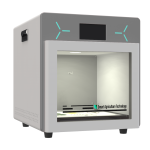Flowerlangtrans VL2
Portable Benchtop Flower Phenotyping System



Applicable Crops : Detached plant parts (flowers, leaves, etc.)
Application Environment : Lab Desktop
Sensor: Visible light 2D
Light Source: Uniform diffuse LED surface light source
View Angles: Top views
Analysis Time: 10s/plant
FlowerLangTrans VL2 is an intelligent phenotyping device mainly designed for the extraction of 2D phenotypic traits of flowering plants under visible light imaging. It can be widely applied in scientific research and production for image acquisition and phenotypic analysis of flowers and other small plant samples. The system helps users quickly detect and analyze plant morphology, color, texture, and other related characteristics.
Portable Benchtop unit + 2D Imaging Control unit + Flower Analysis unit + Data Management unit
Images are automatically named and numbered according to the family, genus, and species.
Manual selection of image regions is supported for color comparison.
Collected and analyzed data can be statistically processed.
Based on the user’s analysis results, the system supports generating a flower phenotyping analysis report.
40+ plant parameters can measure
Morphological Parameters:
Length, width, perimeter, area, quantity, etc.
Color Parameters:
R/G/B color components, RHS color comparison, etc.
Texture Parameters:
Contrast, uniformity, etc.
After repeated validation, the system can be applied to the following applications:
